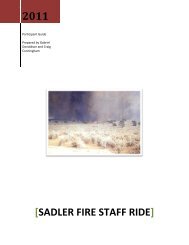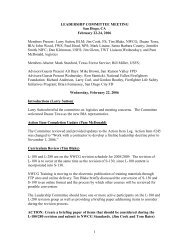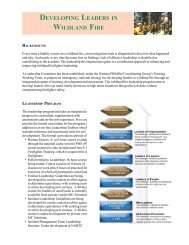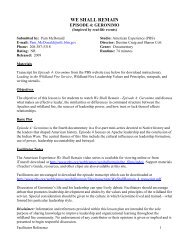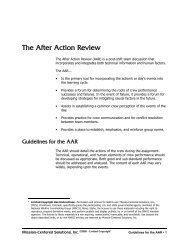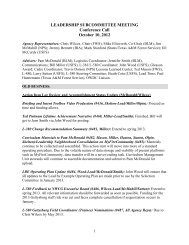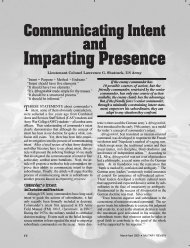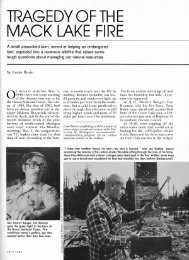example tdgs/stex #2 - Wildland Fire Leadership Development
example tdgs/stex #2 - Wildland Fire Leadership Development
example tdgs/stex #2 - Wildland Fire Leadership Development
You also want an ePaper? Increase the reach of your titles
YUMPU automatically turns print PDFs into web optimized ePapers that Google loves.
As you drive up toward the radio tower site you see the fire has laid down<br />
(DESCRIBE: How the smoke column looks). Arriving at the radio tower site, you<br />
get the vehicles parked and size up the area as a safety zone. You walk over and<br />
locate the ridge and looking down you are unable to see any fire activity, but visibility<br />
is obscured by lots of drift smoke. The time is 1000 hours. Now what<br />
In a time limit of 5 minutes decide on a course of action and be ready to brief the two<br />
crews and take any other actions you feel necessary.<br />
Facilitator “Murphy’s Law” Suggestions:<br />
The “Murphy’s Law” suggestions listed below can be added as “What ifs” at any time<br />
during the scenario to raise the stress level of the leader. You can also use one of your<br />
own.<br />
• The parking area is small and marginal for a safety zone<br />
• The fire approaches Division A faster than expected<br />
• The dozers never arrive on Division A<br />
• Technicians for one of the radio stations are on-site and very anxious about the fire<br />
• Loss of radio communication with the Division A Supervisor<br />
Facilitator’s Notes:<br />
This STEX should focus on Strike Team Leader/Task Force Leader level decision<br />
making and communication. In this scenario the player has been presented with midseason<br />
fire conditions and a downhill line construction assignment on the highest<br />
priority division of the incident. The Strike Team Leader must decide how to handle<br />
the downhill line construction and deploy his/her resources.<br />
The Strike Team Leader has the advantage that they are working with their own crew<br />
and a crew that they are familiar with from past assignments. Therefore they know<br />
what they can and cannot expect from the crew leadership and in terms of line<br />
production.<br />
If the Strike Team Leader chooses to scout the proposed line themselves he/she may<br />
choose to take the crew superintendents with them.<br />
They may request to begin line construction from the bottom of the ridge and work to<br />
the top or split their crews and have line production from both directions.<br />
In this TDGS the player’s actual decision (i.e. accepting the downhill line construction<br />
assignment vs. offering alternatives) is of less importance than the reason why he/she<br />
made that choice and the direction given to their resources. Discussion in the AAR<br />
should focus on why the player chose a particular option. Once the “why” has been<br />
36



